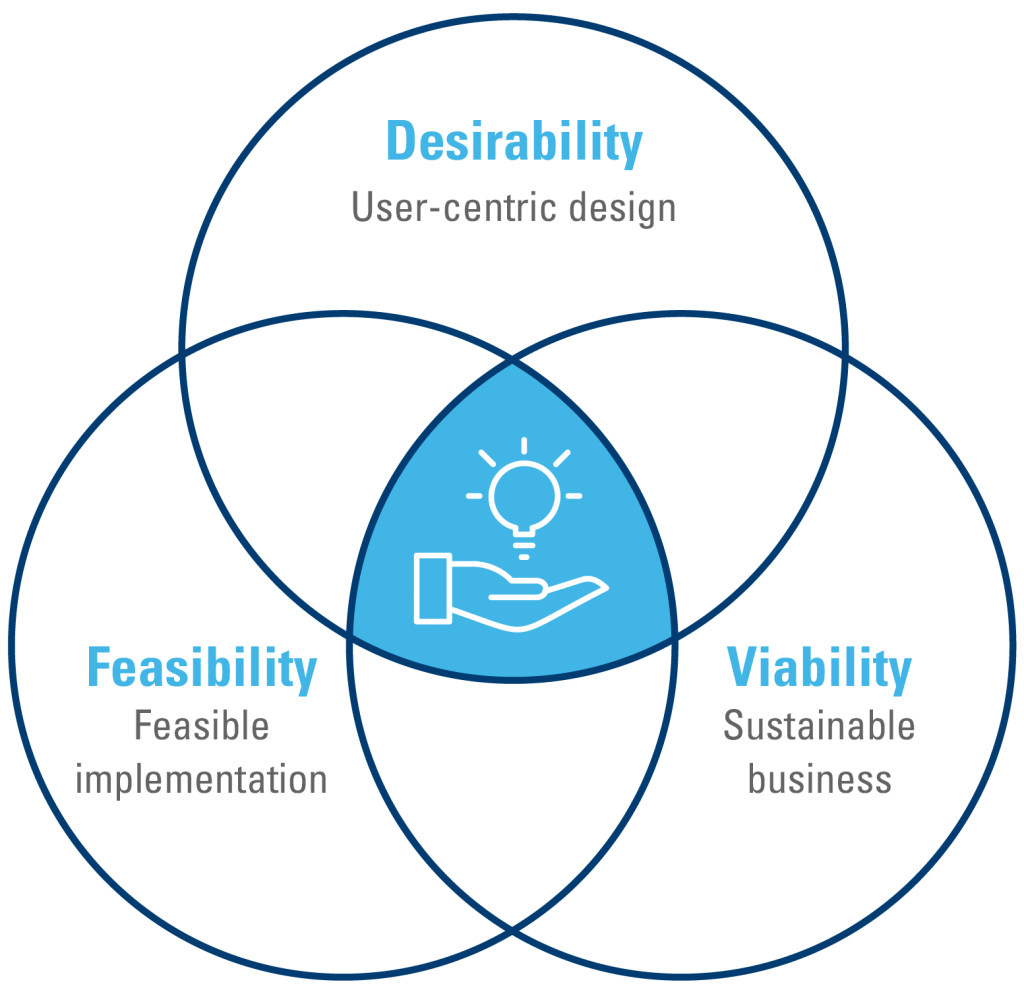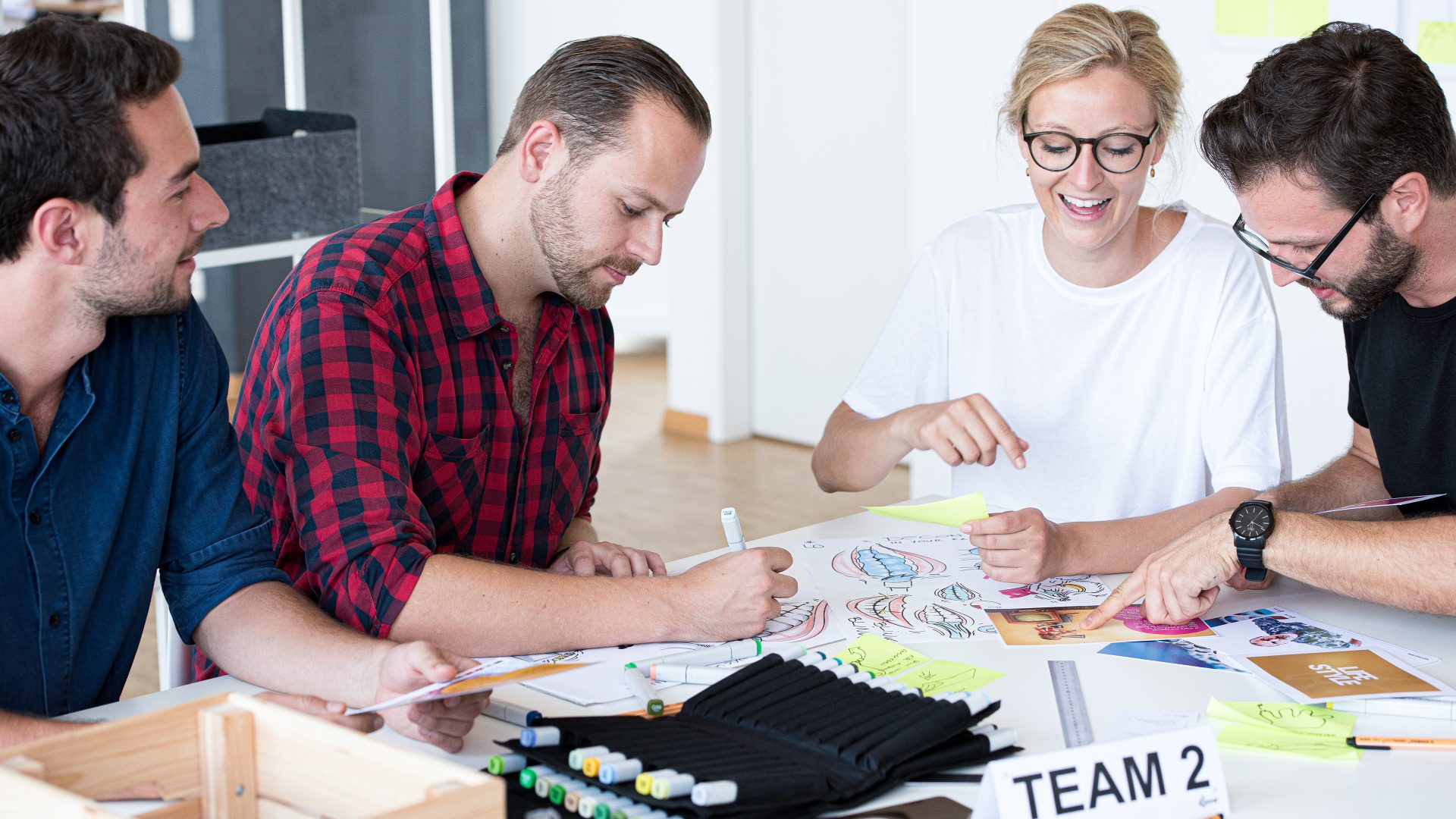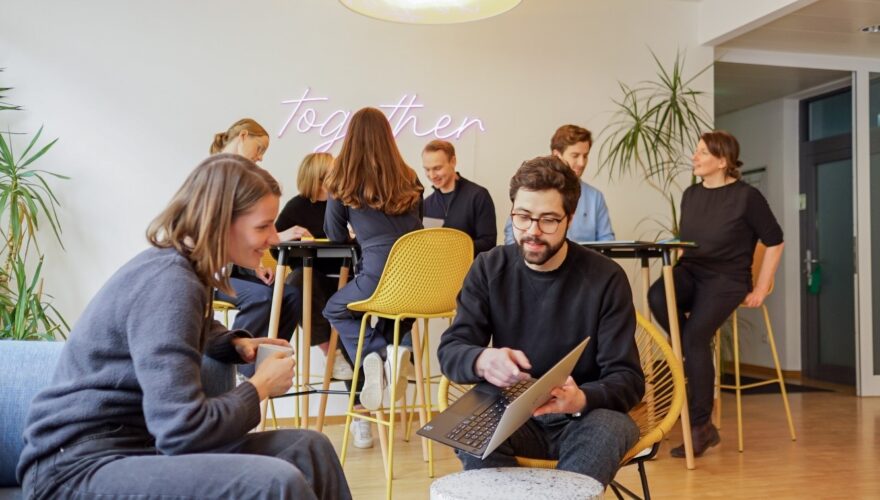What exactly is Design Thinking?
Depending on which sources you look at, Design Thinking is described as a process, a discipline, a set of tools, a method and many more :
- IDEO describes it as a “Method”, a “Process for Creative Problem Solving”, an “Approach” and Tim Brown can also be found quoted saying that “Design thinking can be described as a discipline”
- Stanford introduces it as a set of “principles” and their Design Thinking Bootleg as a “set of tools & methods”
- The Harvard Business Review presents Design Thinking as a “strategy making process” that “applies tools from design” and uses “imaginative, user-centred problem solving”
There is no single definition for design thinking. It is an idea, a strategy, a method and a way of seeing the world.
IDEO
But there are 3 essential pillars in Tim Brown’s definition of the term: “Design thinking is a human-centred approach to innovation that draws from the designer’s toolkit to integrate the needs of people, the possibilities of technology, and the requirements for business success.”
Design Thinking is about ensuring the desirability, feasibility and viability of your innovation
Desirability focuses on the end user of your innovation: who needs what? It is about learning from users about their needs, frustrations and expectations. If your innovation ambition is radical or “transformational” as Monitor’s co-partners Bansi Nagji and Geoff Tuff coined it, you might not know who your future target audience will be. But you can see and sense where the future is going today to define the early adopters of your future product.
Feasibility is about ensuring that your business has the capabilities (or can acquire the capabilities) required to develop and sustain your future innovation: how will I make it work? Feasibility is about resources (people, financial, technology), organizational structures, internal buy-in, partnerships, ecosystems. It requires commitment and vision.
Viability (or as I like to call it “impact”) is the raison d’être of any for-profit company, and it is not only about business model innovation. Impact also applies to any public administration or not-for-profit organization. In fact, impact applies to all organizations because having an impact on your market, your employees, your partners, your customers is not only financial. And without impact, you only have a working invention, not an innovation. What impact am I working to create?
The typical Design Thinking process helps you keep these criteria in check throughout your project.
What does this mean in concrete terms for your project?
The 5 phases of design thinking

- Empathizing with your target audience, your end users, whether B2C or B2B. Discovering, exploring, learning and putting yourself in your end users’ shoes. Being user-centric.
- Defining the problem space, its scope and the opportunity areas that you can innovate around. Being specific.
- Coming up with ideas as a starting point for finding innovative solutions to your problem. At this stage you can already test the ideas with end users and/or turn them into concepts. Prioritization is a key activity at this point.
- Prototyping is about bringing your concepts to life and this activity should be done several times, increasing in fidelity type at each iteration (e.g. from sketches and paper prototypes to digital wireframes and 3D-printed parts). Do it early.
- Testing is an inseparable step from prototyping, it is all about experimentation. Rounds of testing and refining ideas (or abandoning them) based on user feedback and business capabilities is a crucial activity to ensure that your innovation is desirable, feasible and viable.
These last three pillars and the overall process are essential to de-risk innovation. While you might have an appetite for risk, your boss or shareholders will probably not be as hungry for it as you are.
What about Design Thinking workshops?
Hopefully by now you are convinced that Design Thinking is a way of approaching your innovation challenge. I like to say it is a mindset that will help you keep the following 3 pillars in mind throughout your project to de-risk your innovation efforts:

Just like with any mindset or way of doing/working/thinking, it is not a fixed method. It guides you to choose the right methods along your innovation project:
- Maybe a Netnography or a Customer Advisory Board will help me be more user-centric to ensure the desirability of my product or service?
- Maybe stakeholder interviews, Lead User workshops and technology scouting are a good start for me to understand what is feasible for my business but also what capabilities I will need to acquire to realize my innovation?
- Maybe forecasting and a business model prototyping game can help me understand the steps that I will need to take to ensure my future innovation is viable and has the impact that I desire?
So Design Thinking is definitely not a workshop. A workshop is a method which, depending on how it is planned and prepared, can help you achieve many things: understand your users better, co-create product and service ideas internally or externally, experiment with solutions and build prototypes, or prepare and practice innovation pitches to your Management team or Board of directors. Several workshops might be required during your innovation process to help you achieve these objectives. And these objectives are guided by your Design Thinking mindset: I want to ensure desirability, feasibility and viability of my innovation in order to reduce the risk of failure.
If you would like your teams to acquire this Design Thinking mindset, you can approach a company like us to provide training. In a single workshop, a series of workshops or using many other methods, we use Design Thinking to develop a suitable innovation strategy for you.


